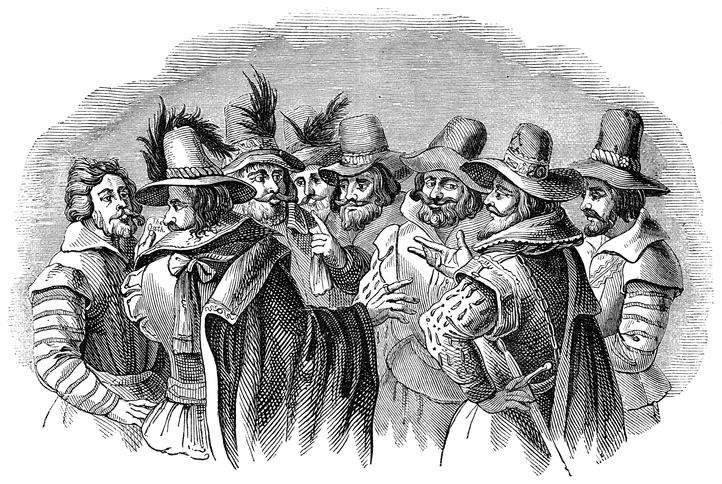The architect of the biggest assassination attempt in British history: Who is Guy Fawkes?
Guy Fawkes, who was born in York, England, on April 13, 1570, would be declared the greatest 'traitor' in British history. Nowadays, Guy Fawkes Day is celebrated every year in England on the night of November 5th.

At the age of 23, Fawkes, a Catholic soldier, joined the Dutch unit of the Spanish army. He returned to England in 1604 as a very successful soldier.
Fawkes, who met Robert Catesby and other conspirators as soon as he returned to England, would take an active part in the event called 'Gunpowder Plot' with his friends.
The Gunpowder Plot, a rebellion against King James I and other aristocratic groups, took place with the participation of 12 conspirators.
The aim of the Gunpowder Plot was to blow up the British Parliament Building.
When England subordinated the church to the king between 1532 and 1536 and the influence of the clergy on power decreased, Fawkes and his friends, who were not satisfied with this new reform, took action for a government dominated by the Catholic Church.
Guy Fawkes (13 April 1570 – 31 January 1606), also known as Guido Fawkes while fighting for the Spanish, was a member of a group of provincial English Catholics involved in the failed Gunpowder Plot of 1605. He was born and educated in York; his father died when Fawkes was eight years old, after which his mother married a recusant Catholic.
Of course, for this, they had to destroy the current administration and rebuild everything from scratch.
Although Guy Fawkes is known today as a hero fighting for freedom and democracy, he actually wanted to blow up the British Parliament and create a government dominated only by the Catholic Church. In other words, it has nothing to do with today's V for Vendetta concept.
Fawkes and his friends, who wanted to take control of the Catholic Church, took action on November 5, 1605.
Fawkes, who was caught with the gunpowder barrels even though he did not organize the incident, was immediately arrested and executed for treason on January 31.
Although the story of Guy Fawkes ends here, let's talk about why V for Vendetta, which is very much identified with Fawkes, is introduced as someone fighting for freedom.
The only thing Fawkes and V have in common is their actions against the administration.
On this night, celebrated with great festivities, large barrels are set on fire and rolled through the streets, and fireworks are set off to celebrate the death of Guy Fawkes.
Details of the story
When we look at the calendar, the dusty pages today take us to the year 5 November 1605 and England. Guy Fawkes, who signed the action that went down in history as the 'Gunpowder Plot' and became the pioneer of anarchy movements against the oppressive government by some groups, appears before us as our protagonist. However, far from being the protagonist of the incident, Fawkes, who was declared the greatest 'traitor' in the history of England, continues to remember his name every November 5th, let alone the opposing fronts and unsuccessful conspiracies.
Guy Fawkes, who was born on April 13, 1570, became a Catholic in 1593 and joined the Spanish army in the Netherlands. Returning to England, his homeland, in 1604, Fawkes met the anti-government Robert Catesby and those later known as the 'twelve conspirators'. These twelve people, who were against the oppressive state administration and the Catholic monarchical regime, decided to blow up the British Parliament Building in order to carry out an action that would go down in history as the 'Gunpowder Plot'. The action, which coincided with the aristocracy summit that took place in November of each new year in the context of history, targeted not only the king but also the entire royal family and high-ranking statesmen.
His mission was to blow up the building
Guy Fawkes was responsible for blowing up the building in this action. However, the conspiracy was revealed when Francis Tresham, one of the twelve names who later joined the group, warned one of his relatives not to go to the Parliament House on November 5. Fawkes, who was caught with filled barrels of gunpowder in the Parliament cellars, was sentenced to one of the most painful executions in history and was executed on January 31, 1606. The failure of the conspiracy took its place as an important link in the chain of democracy in British history and turned into a tradition of celebration. Over time, this unsuccessful conspiracy began to be celebrated with entertainment and festivities as 'Guy Fawkes night'. Whether it is because they remain true to the essence of the conspiracy or not, the indispensable parts of the festivities are fireworks that illuminate the city and barrels set on fire and roll through the streets.
"Don't forget November 5th" line
Apart from this tradition, November 5th is also of great importance for a work that is at the top of the lists of many movie lovers. The idea behind the mask: V For Vendetta... Our protagonist in this movie, 'V', wears a Guy Fawkes mask on his face due to the burn on his skin and appears with a long wig that resembles Fawkes' hair. Emphasizing that what is important is the ideas behind the mask, our hero emphasizes November 5th with great importance, let alone the physical appearance. Therefore, "Don't forget November 5th" becomes one of the indispensable lines of V For Vendetta. The failed 'Gunpowder Plot' is met with both the explosion of the Parliament Building and the collapse of the oppressive regime, accompanied by a 'concerto playing for justice' in 'V For Vendetta'. Even though events, dates, and names change, the idea behind the mask always remains in the mind. And as we all know, we cannot hold an idea or touch it. Ideas do not bleed, they do not feel pain. Most importantly, ideas are bulletproof...
